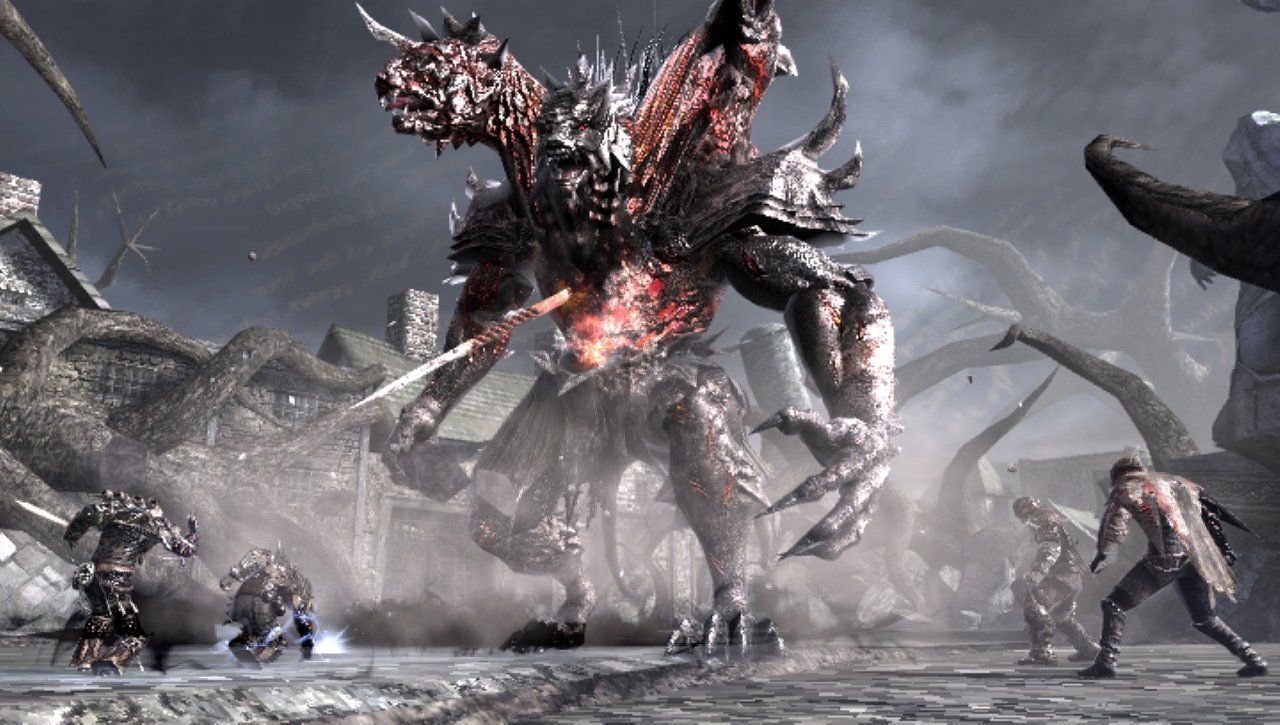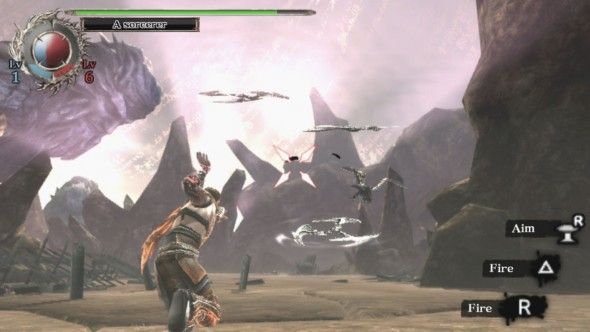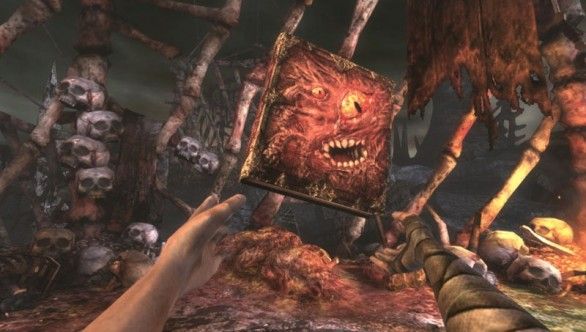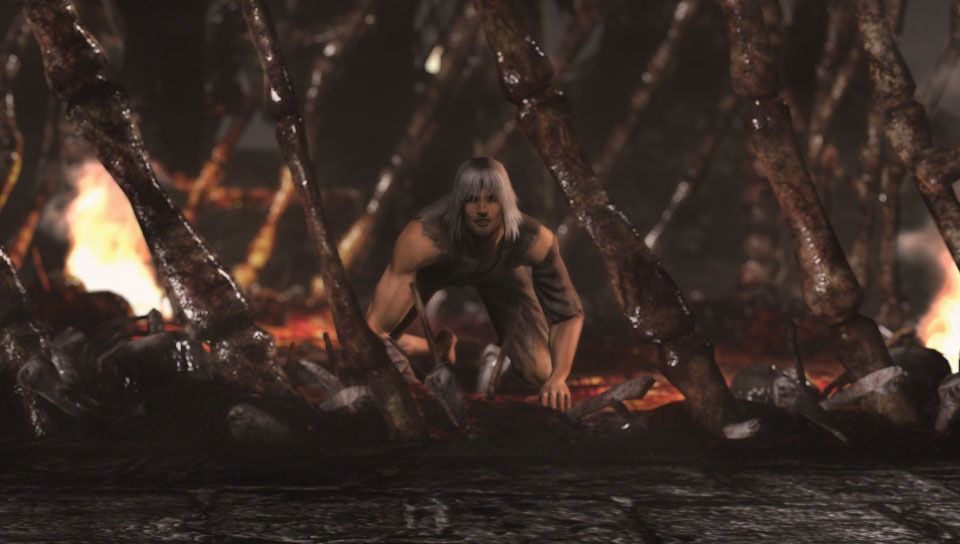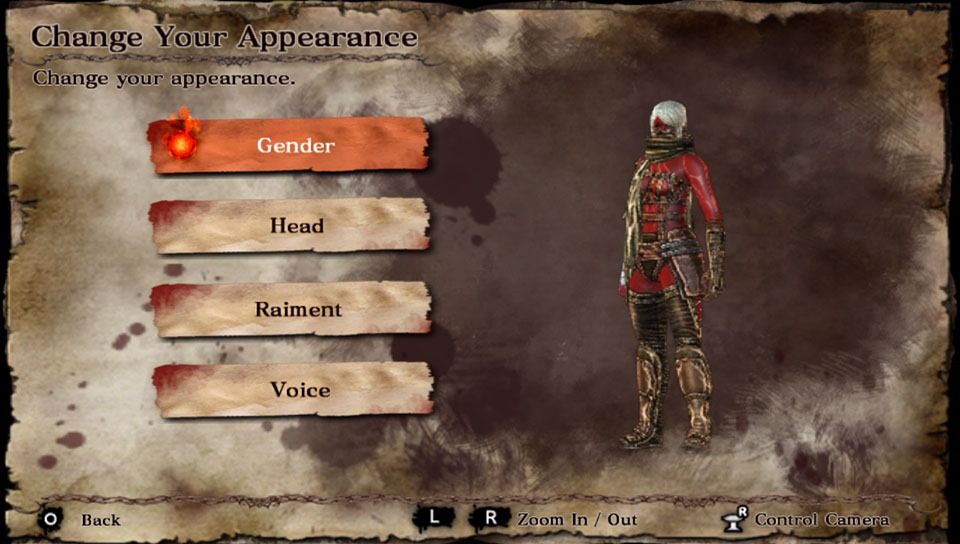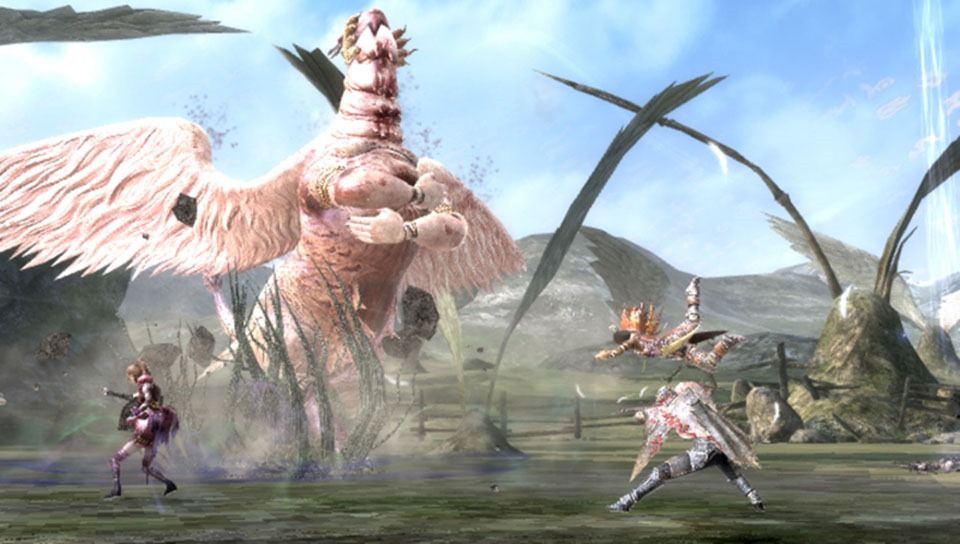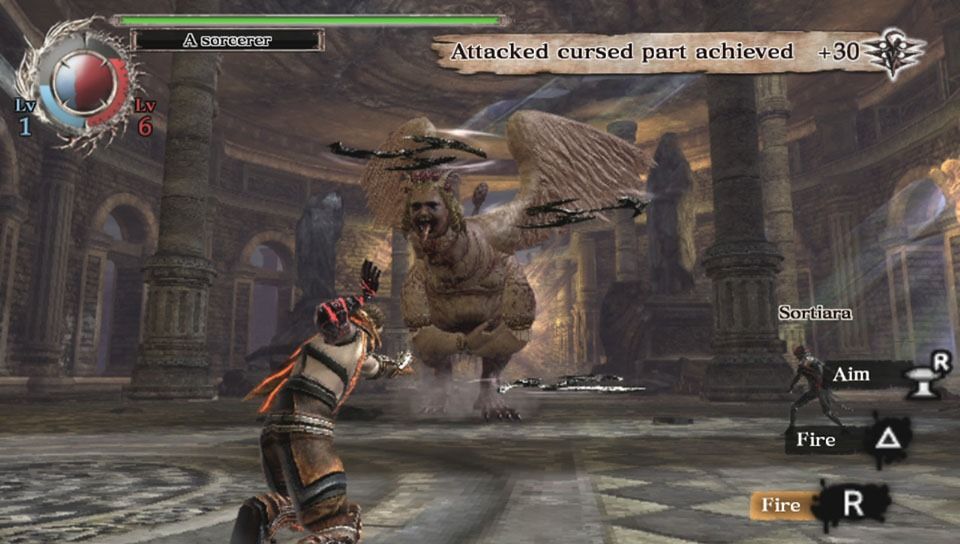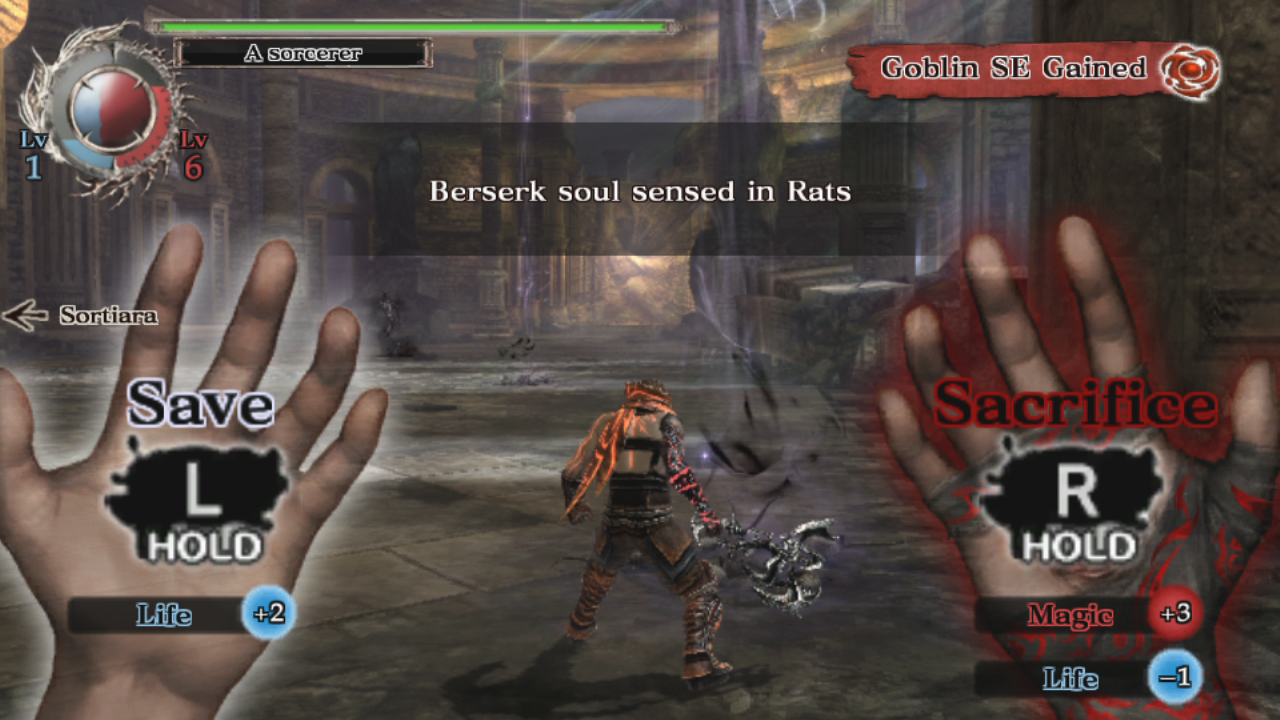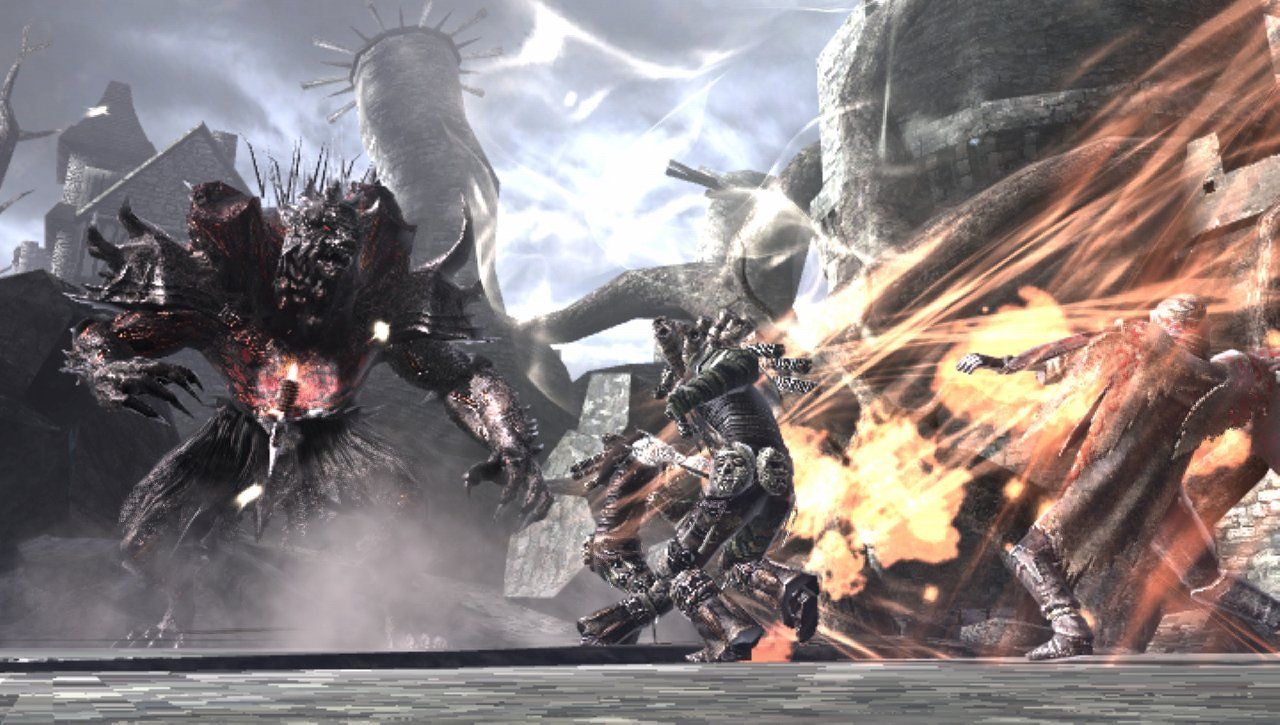With the Monster Hunter series steering clear of the PlayStation Vita, Soul Sacrifice looks to fill a sizable hunting void on the platform. The title is the fruit of one of the first collaborations between Keiji Inafune’s upstart Comcept and Sony’s Japan Studio. While it is by no means perfect, Soul Sacrifice is definitely one of the most unique and exciting action RPGs I’ve played, and its merits are so significant that any Vita owner should give this game a look.
As its name implies, the theme of Soul Sacrifice is sacrifice. This is prevalent in many areas of the game. In the beginning of the game, you are a prisoner being held captive by a fiendishly powerful sorcerer named Magusar and Magusar’s goal is to sacrifice you to further increase his magical abilities. While waiting for your impending demise, a witty talking book named Librom appears before you.
Librom is basically the diary of someone who was close to Magusar before he became the monster he is now. This is the main way the story is conveyed to the player: as you read the diary you relive all of Magusar’s experiences as his friend, and watch his transformation. While there is a huge amount of reading to be done, the writing is good and most of the book is narrated.
Furthermore, there are animations taking place on most of the pages in the story campaign, and these add sharp, appealing effects to what would otherwise be just pages of text. I didn’t really have any problem with this approach to the story, particularly because it was so easy to go a few chapters back and reread them If you were confused about something, but I sometimes wished there were more actual cutscenes. In general, I found the story, which revolves around sacrifice and the sacred chalice, to be interesting throughout, if a tiny bit confusing in some spots.
One of my favorite things about this game is its rich, interesting lore. Each and every enemy you face in the game – from the rats to the hulking behemoths – has a chapter dedicated to it in Librom’s lore section.
Reading about each of the bosses and what they sacrificed to the chalice is thoroughly entertaining, and I spent hours simply flipping through this section and learning about the Phoenix, the Harpy, the Centaur and every other enemy. Why did they seek the chalice? What did they sacrifice for their wish? Furthermore, even each of the stages has some backstory or history to it. The lore section makes it easy to simply get lost in the game’s world and reading about all of the fascinating characters, enemies and locations is addictive.
Everything you do in the game happens in the confines of Librom. The character creation and magic outfitting happens in one chapter, while the free missions are in another chapter, the story campaign is in another and so on. This format looks pretty cool and you can turn the pages and navigate with the Vita’s front touch screen.
Graphically, Soul Sacrifice looks pretty good. The big stages that house all of the battles are detailed and pretty. The enemies are demonstrate a similar level of polish, although some of the created characters can look a bit odd. Some of the spell effects look really cool. The game holds up well, even when you and your fellow sorcerers are setting the field ablaze with powerful elemental spells, summoned monsters and gruesome transformations. There are virtually no CG cutscenes in the game.
The music in Soul Sacrifice is good as well. All of it is orchaestral stuff, with lots of sad strings. The somber melodies can seem somewhat depressing after a while, but they match the theme of the game and the story really well. Uptempo tracks play during battles though, and they do an excellent job of getting you riled up and pumped. Also, I thought the voice acting was pretty good.
Essentially, the game-play of Soul Sacrifice is composed of two core components. These are: character growth/customization and combat. After you make some progress in the main campaign you’ll be able to choose the look of your character. There are a decent amount of options in this area, allowing players to be unique in creating their characters.
While the importance of appearance is debatable, one thing that isn’t is your character’s magic spell set, or their “offerings”. You need good spells to get good scores on the missions and to actually be helpful in the game’s online mode. There are several different offerings you can acquire, perhaps one hundred or more. One of them is a standard point and shoot fire spell, while another blankets the ground around you in toxic poison while yet another conjures a tree, which you and your allies can eat from to gain temporary stat boosts. The huge variety of offerings allows for some very deep strategies against big enemies.
Expanding on this is the ability to fuse some offerings into entirely new offerings and the ability to boost a particular offering using multiples of it. Let’s say you get three of the same fire offering. Initially, you can only use an offering a certain amount of times during a battle before it runs dry (although this can be prevented by sacrificing, which we’ll talk about in a moment) but boosting an offering increases the number of times you can use it. With some spells, it also increases the damage the spells do.
Getting multiples of a powerful spell and boosting it so that you can cast it several times is a time consuming process, although it can be very rewarding if you’re planning on taking on some of the higher level bosses.
In addition to their offerings, you’ll also have to concern yourself with your character’s sigils. Sigils give various bonuses and stat modifiers. The interesting thing is that to unlock sigils for use, you need the essence from certain monsters. Every enemy defeated in the game drops a unique essence or material and these are used to create the sigils. So, as you’ve probably guessed, the better sigils require essences that you get from slaying the big tough enemies, as compared to the runts. You must also slay certain enemies in order to receive certain offerings.
As a result of this, you may find yourself defeating a boss several times in hopes of grinding up enough of a certain essence, or defeating the boss with a high enough score in order to get a certain offering. This makes character progression towards the beginning of the game kind of wonky, as you’ll want stronger spells to kill stronger enemies, but you’ll have to beat stronger enemies to get stronger spells and sigils.
Characters can be developed as either offensive or support characters. After each enemy in the game is defeated, the player has a choice to either save or sacrifice the soul of the enemy. Sacrificing the soul will increase your characters attack stat by a tiny amount and replenish your offerings during a battle. Saving the soul will increase your characters defense or health stat and replenish your health during a battle. If you overuse an offering without replenishing it during a battle, the offering will be destroyed and you won't be able to use it again during the battle. You can reverse this effect after the battle, though.
Whether you save or sacrifice a soul depends on the kind of character you want to build. It seems that most players typically wanted to hit harder and as result mostly sacrificed enemies, but some players focused on healing and support. Another thing you can customize is your character’s black rite. Black rites are powerful spells that can be activated once you’ve taken enough damage. Black rites require a sacrifice of some kind (big surprise there) to be cast. These include your defense stats, your equipped offerings, and other things. The effects of using black rites can be relieved after each battle.
Once you’ve outfitted your character with offerings and sigils, you can jump into a battle or a pact – the game’s meat and potatoes. Fighting in Soul Sacrifice is fast paced and very exciting. Seeing the big variety of spell effects is awesome, and it’s addictive to watch your sorcerer grow steadily stronger. Your movement options are somewhat limited (although some spells can enhance them) but otherwise the controls are tight and responsive. Dodging around firing off spells and sacrificing the souls of your fallen foes will never get old.
The many spells give way to some rich strategies. Exercise a monster’s weakness to ice by freezing it with an ice blanket, ice needles and a frost golem. Then exploit its new weakness to shock with a thunderstone blast and a rising thunder fist.
The single player campaign is made up of several pacts that get steadily more difficult before you face the final boss. Aside from the main campaign, you can also enjoy the Avalon pacts and fellow sorcerer pacts in single player. The Avalon pacts are simply a collections of missions that get more and more difficult, offering better and better rewards. Unlike the main campaign though, you can complete the Avalon pacts online with other players. The fellow sorcerer pacts are a number of smaller story campaigns that focus on other sorcerers and their stories and motivations. These are very interesting and compelling to complete.
While you’re enjoying the single player pacts, you can choose an AI ally. Some of them look pretty cool but unfortunately AI partners really pale in comparison to other players. If I hadn’t made it clear, the game really has quite a bit of content right out of the box. The main campaign could probably be finished in a few hours, but clearing the rest of the pacts will take dozens of hours or longer.
While most of Soul Sacrifice can be completed with AI partners, the arguable biggest draw of the game is its online multiplayer mode. You can take your customized character online and partake in dangerous pacts with as many as three other players, and playing online is really quite fun. Only with other intelligent, powerful player characters can you ever hope to tackle some of the nine or 10 star pacts. Players can heal and support one another with spells. A well coordinated party is a force to be reckoned with.
One of the highlights of the online play is the ability to save or sacrifice your allies when they fall in battle. If you choose to save your ally, they will be resurrected with a bit of health and are free to continue helping defeat the boss. On the other hand, if you sacrifice your ally, their soul will be sacrificed as an offering to summon a very powerful spell. Once they’ve been sacrificed, your ally must sit the rest of the battle out, although they can influence some characters and enemies as a ghost.
Once you’ve been knocked out, you can communicate to the other players what you’d like for them to do with your soul, though it is entirely up to the living players what they actually do. In most cases you’d want to be saved, but if you’ve all been fighting a harrowing battle and you’ve reached the home stretch, the sacrifice spell could be strong enough to end the battle. Also, you are eligible to receive special “martyr bonuses” if you’re sacrificed in a successful battle. Summarily there are advantages to being sacrificed, but most of the time you’ll want to keep playing, meaning you’ll want to be saved.
The fact that the players choose what to do with you is both a blessing and a curse. Some players are jerks and will sacrifice any and everyone who falls, which eventually results in a loss since a single player is not nearly enough to defeat the stronger bosses. On the other hand, a player that just runs around stealing souls without actually helping defeat the boss could be more useful as a sacrifice spell than as an actual player. These things can be worth considering as opposed to simply saving every player who begs you to.
With the expanse of online content, it’s worth mentioning that you’re going to need the internet if you plan on getting the most out of Soul Sacrifice. You could enjoy the story campaign, lore, fellow sorcerer pacts and several of the Avalon pacts all by yourself, but you’ll need the internet if you want to enjoy the crazy fun multiplayer and the toughest pacts. Plus you bring all experience and items gained online back to your offline game, which makes grinding experience much easier towards the beginning of the game since you and other low leveled sorcerers can punch above your weight in the Avalon pacts.
Also, Sony has been steadily releasing free DLC pacts with new monsters (and therefore new lore, yes!). Finally, you can post to Twitter and Facebook from in-game, use AR features and use a gift giving feature with Near. So while the game is still worth playing without the internet, you’ll be missing out on a quite a bit of content.
Either way, Soul Sacrifice deserves a shot. It has an entertaining story, tons of intriguing lore, very deep magic, sigil and rite systems, stellar combat and a strong multiplayer component. It could benefit from more cutscenes and some true exploration or adventuring, but what it does it does well. Building your character and taking him online to fight devastating giants with other players is a joy that genre fans are definitely familiar with. There is enough content here to really sink your teeth into and meeting the level cap, earning all the offerings and sigils and clearing all the pacts could take hundreds of hours.
If this kind of multiplayer action RPG is your thing, then you can’t go wrong with Soul Sacrifice.

